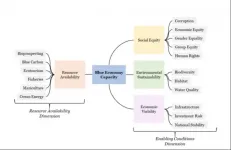To enable the analysis of a cells' complete collection of RNAs known as their transcriptome in their 3D space (spatial transcriptomics), Wyss Institute synthetic biologists led by Core Faculty member George Church, Ph.D. in 2014 reported FISSEQ, an impactful spatial sequencing technology that is able to simultaneously read the sequences of thousands of those RNAs and visualize their three-dimensional coordinates. However, FISSEQ's powerful ability to sequence this large number of RNA targets on-location comes at a price: its detection efficiency and sensitivity for many of them is relatively low, especially when their expression is low to start with or dialed down in disease.
Now, Church's team has developed a new RNA detection method named BOLORAMIS (short for "Barcoded Oligonucleotides Ligated On RNA Amplified for Multiplexed and parallel In Situ analyses") that overcomes this problem. BOLORAMIS designs and uses a new type of DNA probe that directly binds its RNA target and allows the straight-forward synthesis of a barcoded DNA amplicon, which can be visualized by fluorescent in situ hybridization (FISH) or sequenced in situ. BOLORAMIS enables the analysis of different classes of RNAs with higher specificity and sensitivity than FISSEQ and other methods, works in the context of cells and tissues, and can be highly multiplexed. The study is published in Nucleic Acids Research.
"With BOLORAMIS we have solved some of the challenges that technologies in the spatial transcriptomics field are facing. It gives us a significant advantage for understanding the behavior of molecular networks in normal and pathological processes, and for investigating new drug targets, and developing clinical diagnostics in the native context of tissues that we now can capitalize on," said Church, who is the lead of the Wyss Institute's Synthetic Biology platform, and Professor of Genetics at Harvard Medical School (HMS) and of Health Sciences and Technology at Harvard and MIT.
"The strength of BOLORAMIS lies in the fact that its optimized probes have a very short footprint on RNAs, and that it does away with the need to first generate a DNA replica of RNA molecules in a 'reverse transcriptase' step, which can produce unspecific results and is expensive," said co-first author Songlei Liu, a graduate student working on Church's team.
In FISSEQ, all RNAs are first fixed in place, and then the entire RNA sequence is copied into its complementary DNA sequence (reverse transcription), which is then circularized and amplified into larger balls of DNA. Those can be sequenced and visualized under a specialized fluorescence microscope. "In BOLORAMIS, by bypassing this reverse transcription step, and directly amplifying the RNA signal, we reduce non-specific and false fluorescent signals," said Liu.
BOLORAMIS probes bind like a padlock tightly and with high specificity to a small sequence of only 25 nucleotides in an RNA molecule and thus have a much smaller footprint than other targeted spatial transcriptomics methods, which enhances resolution. In addition, the probes contain barcode sequences that assign a unique molecular zip code to each RNA target species. Upon hybridization of the barcoded padlock probes to RNA, they are circularized and amplified into a tiny amplicon at the target RNA's location, without the need for a reverse transcription step. The amplicon then can be sequenced in situ, or localized with high sensitivity using a second type of probe, known as fluorescent In Situ Hybridization (FISH) probe, which recognizes the multiple barcodes contained in a single amplicon.
The team first explored BOLORAMIS's quantitative capabilities in human induced pluripotent stem cells (iPSCs) by quantifying the levels of 77 mRNAs encoding a range of transcription factors and those of 77 non-coding RNAs with other functions in gene regulation. While BOLORAMIS consistently demonstrated high and localized expression of RNAs that correlate with "stemness" in the cells, it revealed low expression of RNAs that promote differentiation. In a cancer cell line, BOLORAMIS was able to quantitatively trace the location and movements of a non-coding RNA known as MALAT1 that shuttles between two different subcellular locations, the nucleus and cytoplasm. In addition, the researchers demonstrated that BOLORAMIS can trace a common RNA with high sensitivity in cells located in a much more complex tissue environment of cultured human brain organoids.
"It was of critical importance to us to be able to use BOLORAMIS for the multiplexed analysis of many RNAs, which we hoped the new probe design would allow," said co-first author Sukanya Punthambaker, Ph.D., a Postdoctoral Fellow on Church's team. Indeed, a software suite developed by co-author Andrew Pawlowski predicts ideal probes for any gene sequence that then can be synthesized as comprehensive libraries for specific purposes. The team has made this tool available on the GitHub server. "We used a co-culture system of neuronal cells and brain microglia which are known to interact in many normal and disease processes, and targeted 96 different messenger RNAs simultaneously," said Punthambaker. "This allowed us to uncover the spatial relationships between specific cells and RNAs."
"In future research, BOLORAMIS's high functionality in complex human tissues and human-specific organoids may well give us an edge in deciphering RNA signatures related to neurological disorders," added Senior Staff Scientist Jenny Tam, Ph.D., who co-authored the study and integrates some of Church's research activities at the Wyss Institute.
"Assessing the precise locations and levels of RNA molecules within whole cells with the greater efficiency and accuracy that the BOLORAMIS method provides should significantly advance our ability to understand how cell and tissue organization impact normal physiology as well as complex disease states, and hence facilitate development of new therapeutics and diagnostics for innumerable applications," said Wyss Founding Director Donald Ingber, M.D., Ph.D., who is also the Judah Folkman Professor of Vascular Biology at HMS and Boston Children's Hospital, and Professor of Bioengineering at the Harvard John A. Paulson School of Engineering and Applied Sciences.
INFORMATION:
Other authors on the study are Eswar Iyer, Ph.D., Thomas Ferrante, Daniel Goodwin, Daniel Fürth, Ph.D., Kunal Jindal, Lauren Mifflin, Shahar Alon, Ph.D., Anubhav Sinha, Asmamaw Wassie, Ph.D., Fei Chen, Ph.D., Anne Cheng, Valerie Willocq, Katharina Meyer, Ph.D., King-Hwa Ling, Ph.D., Conor Camplisson, Richie Kohman, Ph.D., John Aach, Ph.D., Je Hyuk Lee, M.D., Ph.D., Bruce Yankner, Ph.D., Professor of Genetics and Neurology at HMS, and Edward Boyden, Ph.D., Professor at MIT's Departments of Brain and Cognitive Sciences, Media Arts and Sciences, and Biological Engineering. It was funded by the National Institutes of Health under grant# RM1 HG008525 and 5R01MH113279-04.
PRESS CONTACTS
Wyss Institute for Biologically Inspired Engineering at Harvard University
Benjamin Boettner, benjamin.boettner@wyss.harvard.edu, +1 617-432-8232
The Wyss Institute for Biologically Inspired Engineering at Harvard University uses Nature's design principles to develop bioinspired materials and devices that will transform medicine and create a more sustainable world. Wyss researchers are developing innovative new engineering solutions for healthcare, energy, architecture, robotics, and manufacturing that are translated into commercial products and therapies through collaborations with clinical investigators, corporate alliances, and formation of new startups. The Wyss Institute creates transformative technological breakthroughs by engaging in high risk research, and crosses disciplinary and institutional barriers, working as an alliance that includes Harvard's Schools of Medicine, Engineering, Arts & Sciences and Design, and in partnership with Beth Israel Deaconess Medical Center, Brigham and Women's Hospital, Boston Children's Hospital, Dana-Farber Cancer Institute, Massachusetts General Hospital, the University of Massachusetts Medical School, Spaulding Rehabilitation Hospital, Boston University, Tufts University, Charité - Universitätsmedizin Berlin, University of Zurich and Massachusetts Institute of Technology.
By Benjamin Boettner


